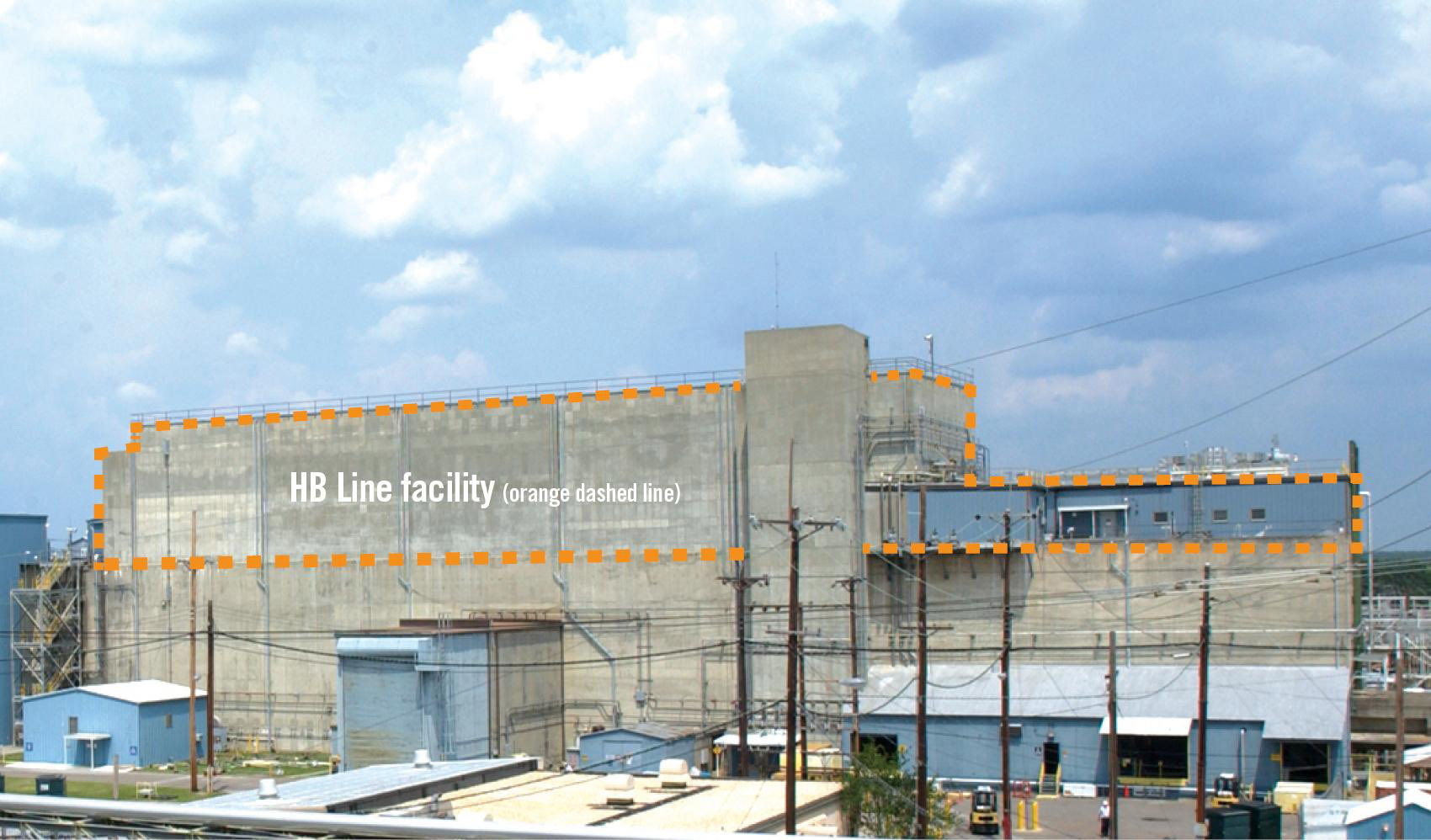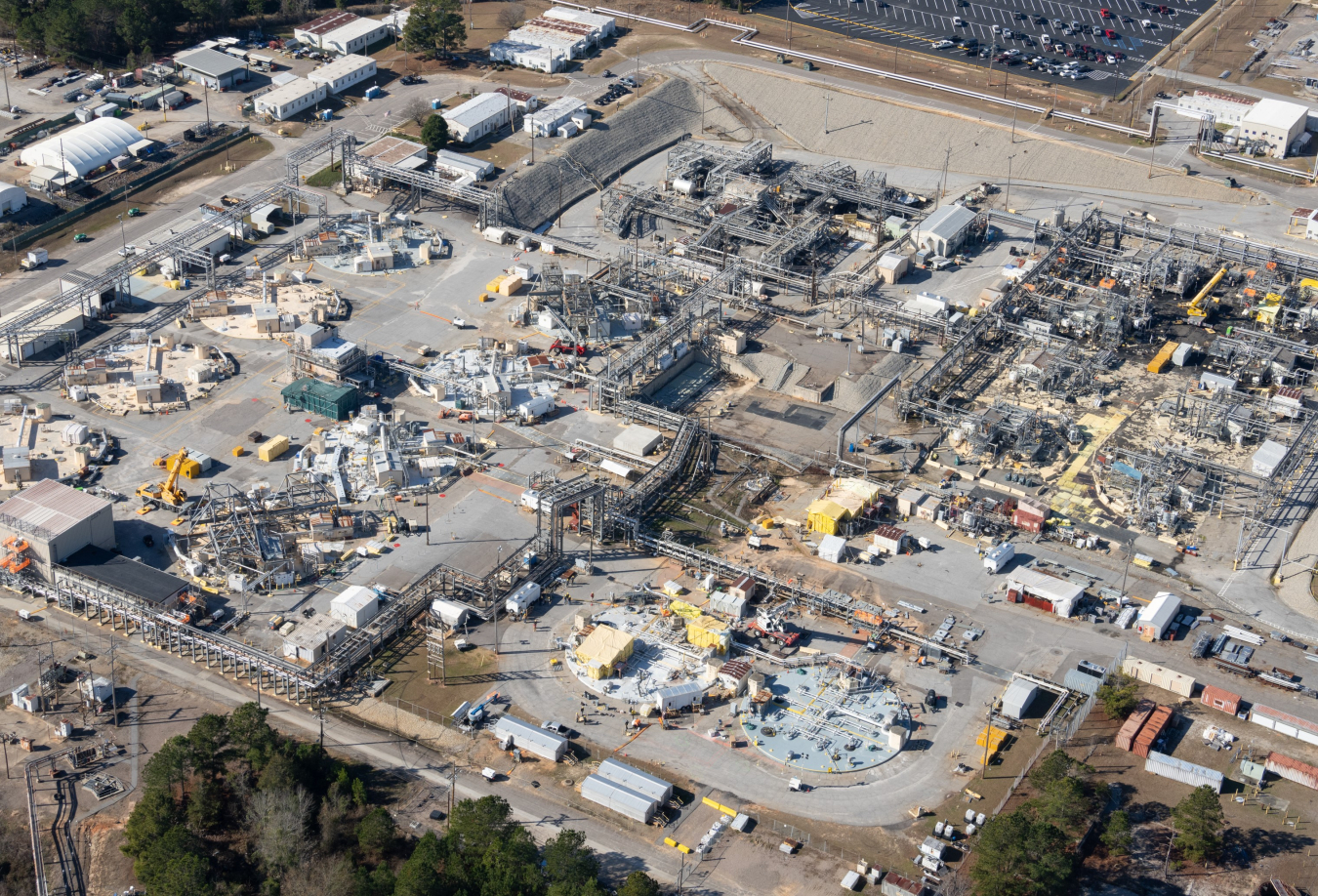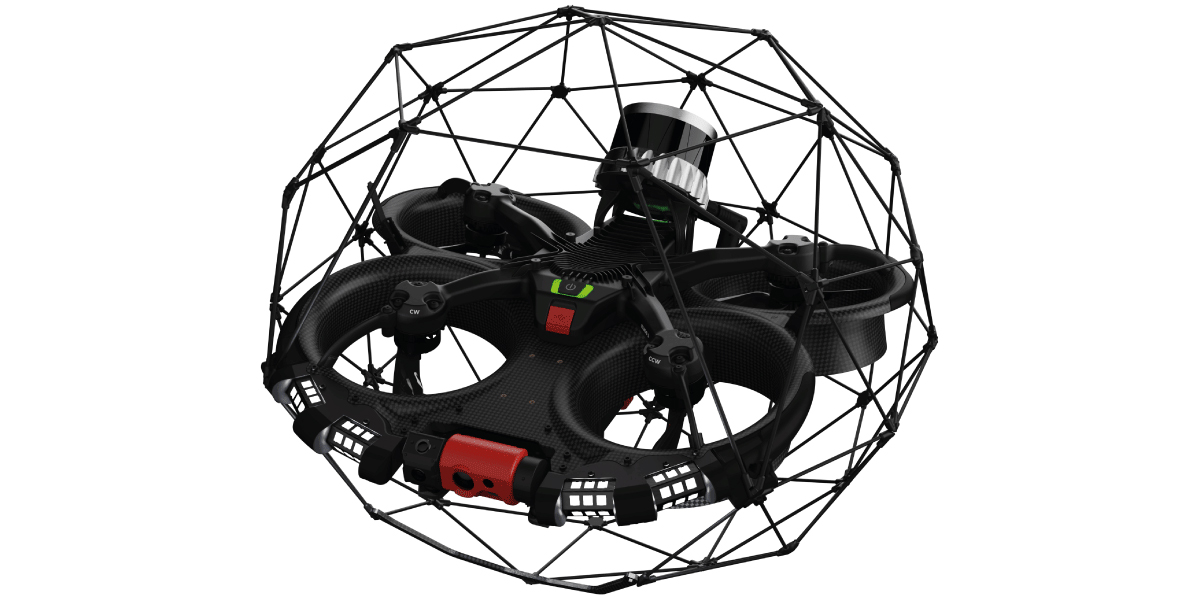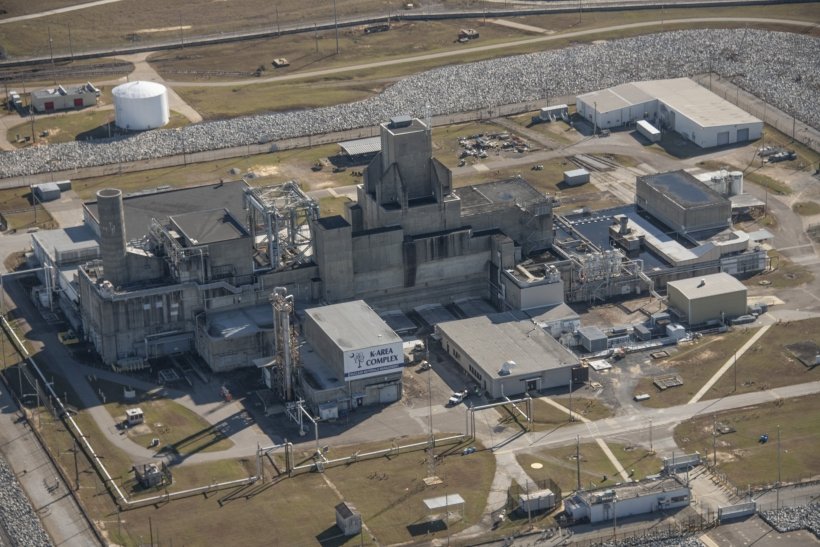H Canyon under construction in the early 1950s (left) and in 2010. (Photos: Savannah River Site)
From 2003 to 2011, staff at the Department of Energy’s Savannah River Site downblended high-enriched uranium in the site’s H Canyon, producing over 300 metric tons (MT) of low-enriched uranium that was fabricated into fuel. The facility has since been idled, but downblending could soon begin again—this time to high-assay low-enriched uranium (HALEU).
Simulator instructor Marc Widener at the controls of a new crane simulator for the Savannah River Site’s Defense Waste Processing Facility.
The Department of Energy’s Office of Environmental Management said it will use a new simulator to help train operators on the safe and efficient movement of a remotely operated crane at the Defense Waste Processing Facility (DWPF) at the Savannah River Site in South Carolina. The DWPF, where Savannah River’s liquid high-level radioactive waste is vitrified and placed into storage containers, uses an unmanned bridge crane system to install and replace equipment in the high-humidity, high-radiation, and harsh chemical environment of the facility’s processing cells.
The Savannah River Site’s HB Line facility is located on top of the H Canyon chemical separations facility. (Photo: DOE)
The Department of Energy has announced that workers at its Savannah River Site in South Carolina recently removed legacy uranium materials from the site’s HB Line as part of an effort to clear the facility of its inventory of legacy nuclear materials. The removed legacy uranium was originally produced by the Y-12 National Security Complex at Oak Ridge, Tenn.
The Savannah River Site’s F Tank Farm, where Tank 4 completed preliminary cease waste removal a year ahead of schedule. (Photo: DOE)
The Department of Energy’s Office of Environmental Management said it has reached a regulatory milestone ahead of schedule in preparing radioactive waste tanks for closure at the Savannah River Site in South Carolina. DOE-EM said it received concurrence in January from the South Carolina Department of Environmental Services (SCDES) and the U.S. Environmental Protection Agency that SRS had successfully removed waste from the site’s Tank 4 and may now proceed to waste sampling and analysis of that tank ahead of its closure.
SRS liquid waste contractor Savannah River Mission Completion will use drones equipped with cameras to inspect the cleaning status of waste tanks at the site. (Photo: DOE)
The Department of Energy’s Office of Environmental Management will begin using drones for the first time to internally inspect radioactive liquid waste tanks at the department’s Savannah River Site in South Carolina. Inspections were previously done using magnetic wall-crawling robots.
SRNS’s Sean Alford (standing) discusses career opportunities with Winthrop University faculty and staff during a tour of the Savannah River Site. (Photo: SRNS)
Faculty and staff from Winthrop University recently toured the Department of Energy’s Savannah River Site as part of a workforce development partnership.
Aiken County Public School District students test out a mock glovebox during a tour of the Savannah River Site’s Waste Solidification Building. (Photo: SRNS)
Fifteen area high school students recently completed job shadow experiences with leaders, engineers, and education outreach personnel at the Department of Energy’s Savannah River Site in South Carolina, according to Savannah River Nuclear Solutions (SRNS).
Operators in plastic suits prepare for drum venting operations. (Photo: DOE/SRNS)
Department of Energy contractor Savannah River Nuclear Solutions (SRNS) said its Savannah River Site employees recently used an innovative method to ensure the integrity of radioactive material storage containers currently in long-term dry storage at the South Carolina site.
The 2023 SRNS SCM apprentices and interns pose with SRNS president and chief executive officer Dennis Carr (on the far right). Front row, from left: Nicholas Diacetis, Ekaterina Lyamtseva, Rachel Boyd, Brandy Edwards, Morgan Wise, Taylor Davis. Back row, from left: Jonathan Forde, Roy Niblett, Blake Elam, Kale Arrington, Derek Amick, and William Lawson.
So far this year, Savannah River Nuclear Solutions Supply Chain Management (SCM) apprenticeship program has transitioned 12 new graduates to its team. According to SRNS, the apprentices and interns were attracted to the training program through new recruiting connections that SRNS has established with universities and colleges in the Aiken, S.C., area. The SCM program, which is designed to transition participants into full-time positions at the Savannah River Site, has recently increased internal incentives.
Ray Tran, an engineer for Savannah River tank farms, helps complete a timeline of SRS historical events as part of SRMC’s vision casting training initiative. (Photo: DOE)
More than 3,000 employees with Department of Energy contractor Savannah River Mission Completion (SRMC) participated in a vision casting initiative, learning more about the past, present, and future of the Savannah River Site’s liquid waste mission.
Some of the participants of the recent SRNL-Hanford Analytical Knowledge Sharing Workshop pause for a photo. (Photo: DOE)
SRNS Internship Program students sign and accept their full-time position offers at the Savannah River Site as SRNS executives, managers, and mentors look on (Photo: SRNS)
Dozens of students from the Savannah River Nuclear Solutions (SRNS) Internship Program were recently offered a chance at full-service positions during what SRNS called a signing day event held at the Department of Energy’s Savannah River Site, near Aiken, S.C.
Jared Wicker of SRNS explains how different technologies are used to monitor the environment at SRS. (Photo: DOE)
Claflin University students recently toured the Department of Energy’s Savannah River Site in South Carolina to learn about the facilities and occupations there.
The DOE's Savannah River Site. (Photo: DOE)
The Defense Nuclear Facilities Safety Board (DNFSB) is scheduled to visit the Department of Energy’s Savannah River Site in South Carolina the week of May 8 to discuss ongoing safety concerns and the protection of the public and workforce, as well as the DOE’s effectiveness in addressing those concerns.
A view of Savannah River’s K Area, where employees began downblending plutonium in 2016. (Photo: DOE)
Contractor employees at the Department of Energy’s Savannah River Site in South Carolina recently exceeded their plutonium downblending goal for 2022 ahead of schedule as part of the ongoing activities to remove Pu from the state, the DOE’s Office of Environmental Management (EM) announced.
The third cohort of the Nuclear Operator Apprenticeship Program was recognized in a ceremony at Aiken Technical College. (Credit: SRNS)
Twenty-three students in the third cohort of the Savannah River Nuclear Solutions (SRNS) Nuclear Operator Apprenticeship Program graduated recently following their completion of the Nuclear Fundamentals Certificate curriculum at Aiken Technical College (ATC) in South Carolina. The class was the largest ever of operator apprentices to graduate from the program. Those graduates who meet all employment requirements are eligible for hire at the Savannah River Site.
SRNS environmental engineers Bryce Garner (left) and Adam Willey (center) ask questions of lead operator Daniel Ferrell (right), from field services contractor Cascade Environmental, as he describes how equipment injects oil and iron into the Savannah River Site’s groundwater. (Photo: DOE)
In this week’s “EM Update,” the Department of Energy’s Office of Environmental Management (EM) reports that its contractor Savannah River Nuclear Solutions (SRNS) has successfully reduced degreasing solvents in the aquifer beneath the Savannah River Site in South Carolina using a technology that injects a form of iron and oil into groundwater.
“The oil attracts the Cold War[–era] cleaning solvents while the iron degrades and neutralizes the contamination,” said Shannan Lucero, SRNS manager for area closure projects.
Workers demolish a large industrial cooling tower built in 1952 at the DOE’s Savannah River Site. (Photo: SRNS)
Savannah River Nuclear Solutions (SRNS), the management and operations contractor for the Department of Energy’s Savannah River Site, has torn down a large industrial cooling tower at the site’s D Area complex. The cooling tower, built in 1952, is one of more than 30 structures being removed from SRS’s D Area as the DOE works to reduce the site’s footprint.














 Citizens for Nuclear Technology Awareness
Citizens for Nuclear Technology Awareness



